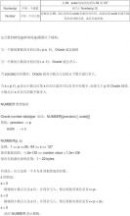一 : Decimal与Number(Numeric)的区别
一般用Decimal。 都用于精确存储数值,MSSQL中Decimal与Numeric同义:
何谓精度:最多可以存储的十进制数字的总位数,包括小数点左边和右边的位数。该精度必须是从 1 到最大精度 38 之间的值。默认精度为 18。
小数位数:小数点右边可以存储的十进制数字的最大位数。小数位数必须是从 0 到 p 之间的值。仅在指定精度后才可以指定小数位数。默认的小数位数为 0;因此,0 <= s <= p。
Oracle中Decimal与Number的区别 :一般用Number。
一、DECIMAL类型详细
Oracle只是在语法上支持decimal类型,但是在底层实际上它就是number类型,支持decimal类型是为了能把数据从Oracle数据库移到其他数据库中(如DB2等)。
因为decimal在Oracle底层就是number类型,所以就当number类型使用就可以了,如果需要对这种字段类型转为char类型可以用to_char函数对其转换。
decimal类型从根本上说应该是数字类型的,因为oracle内部的数据类型,对于数字只有number类型,都当数字类型进行处理即可。decimal(8,2)代表数字总共8位长度,

小数部分是2位。范围是8位,精确到小数点后2位,并四舍五入,即存6位整数,两位小数。也就是最大值可以是999999.99,可存放2位小数。Oracle中,可以使用to_char函数对数字进行转换,使它变成字符类型.
二、NUMBER类型详细
在Oracle中Number类型可以用来存储0,正负定点或者浮点数,可表示的数据范围在
1.0 * 10(-130) —— 9.9...9 * 10(125) {38个9后边带88个0}
的数字,当Oracle中的数学表达式的值>=1.0*10(126)时,Oracle就会报错。
Number的数据声明如下:

eg:
Actual Data Specified As Stored As
----------------------------------------
123.89 NUMBER 123.89
123.89 NUMBER(3) 124
123.89 NUMBER(6,2) 123.89
123.89 NUMBER(6,1) 123.9
123.89 NUMBER(4,2) exceeds precision (有效位为5, 5 > 4) 123.89 NUMBER(6,-2) 100
.01234 NUMBER(4,5) .01234 (有效位为4)
.00012 NUMBER(4,5) .00012
.000127 NUMBER(4,5) .00013
.0000012 NUMBER(2,7) .0000012
.00000123 NUMBER(2,7) .0000012
1.2e-4 NUMBER(2,5) 0.00012
1.2e-5 NUMBER(2,5) 0.00001
123.2564 NUMBER 123.2564
1234.9876 NUMBER(6,2) 1234.99
12345.12345 NUMBER(6,2) Error (有效位为5+2 > 6)
1234.9876 NUMBER(6) 1235 (s没有表示s=0)
12345.345 NUMBER(5,-2) 12300
1234567 NUMBER(5,-2) 1234600
12345678 NUMBER(5,-2) Error (有效位为8 > 7)
123456789 NUMBER(5,-4) 123460000
1234567890 NUMBER(5,-4) Error (有效位为10 > 9)
12345.58 NUMBER(*, 1) 12345.6
0.1 NUMBER(4,5) Error (0.10000, 有效位为5 > 4) 0.01234567 NUMBER(4,5) 0.01235
0.09999 NUMBER(4,5) 0.09999
三、Oracle语句距离
项目中的语句:
[sql] view plaincopyprint? 1. SELECT (CASE WHEN tt1.statistics_date is not null THEN tt1.statistics_date E
LSE tt2.statistics_date END) AS statistics_date, NVL(tt1.actuser,0) AS actuser, NVL(tt2.new_user,0) AS new_user
2. FROM
3. (
4. SELECT t.statistics_date, SUM(t.actuser) AS actuser FROM pdt_stat_act
_1133_i t WHERE t.statistics_date like '2013-04%' and t.statistics_month = '2013-04' GROUP BY t.statistics_date
5. ) tt1
6. FULL JOIN
7. (
8. SELECT t2.statistics_date, SUM(t2.new_user) OVER(ORDER BY t2.stati
stics_date) AS new_user FROM (SELECT statistics_date AS statistics_date, SUM(new_user) AS new_user FROM pdt_stat_newuser_1133_i WHERE statistics_date like '2013-04%' GROUP BY statistics_date) t2
9. ) tt2 ON tt1.statistics_date = tt2.statistics_date
更多 1
?
? 上一篇读书笔记-Don't Make Me Think(Steve Krug) 下一篇oracle中的number数据类型的浅析
二 : Zw*与Nt*的区别
某些Zw*和Nt*函数既在ntdll.dll中导出又在ntoskrnl.exe中导出,他们有什么区别呢?
我们分三部分比较:
step 1: ntdll.dll中的Zw*和Nt*有什么区别?
step 2: ntoskrnl.exe中的Zw*和Nt*有什么区别?
step 3: ntdll.dll中的Zw*与ntoskrnl.exe中的Zw*有什么区别?
ntdll.dll中的Nt*与ntoskrnl.exe中的Nt*有什么区别?
在下面的讨论中我们以ZwCreateFile和NtCreateFile为例
讨论前:我先贴点Kd给我们的答案
Part1:
kd> u Ntdll! ZwCreateFile L4
ntdll!ZwCreateFile:
77f87cac b820000000 mov eax,0x20
77f87cb1 8d542404 lea edx,[esp+0x4]
77f87cb5 cd2e int 2e
77f87cb7 c22c00 ret 0x2c
kd> u Ntdll! NtCreateFile L4
ntdll!ZwCreateFile:
77f87cac b820000000 mov eax,0x20
77f87cb1 8d542404 lea edx,[esp+0x4]
77f87cb5 cd2e int 2e
77f87cb7 c22c00 ret 0x2c
Part2:
kd> u Nt!ZwCreateFile L4
nt!ZwCreateFile:
8042fa70 b820000000 mov eax,0x20
8042fa75 8d542404 lea edx,[esp+0x4]
8042fa79 cd2e int 2e
8042fa7b c22c00 ret 0x2c
kd> u Nt!NtCreateFile L14
nt!NtCreateFile:
804a7172 55 push ebp
804a7173 8bec mov ebp,esp
804a7175 33c0 xor eax,eax
804a7177 50 push eax
804a7178 50 push eax
804a7179 50 push eax
804a717a ff7530 push dword ptr [ebp+0x30]
804a717d ff752c push dword ptr [ebp+0x2c]
804a7180 ff7528 push dword ptr [ebp+0x28]
804a7183 ff7524 push dword ptr [ebp+0x24]
804a7186 ff7520 push dword ptr [ebp+0x20]
804a7189 ff751c push dword ptr [ebp+0x1c]
804a718c ff7518 push dword ptr [ebp+0x18]
804a718f ff7514 push dword ptr [ebp+0x14]
804a7192 ff7510 push dword ptr [ebp+0x10]
804a7195 ff750c push dword ptr [ebp+0xc]
804a7198 ff7508 push dword ptr [ebp+0x8]
804a719b e8b284ffff call nt!IoCreateFile (8049f652)
804a71a0 5d pop ebp
804a71a1 c22c00 ret 0x2c
1) Part1 输出的是Ntdll.dll中ZwCreateFile和NtCreateFile的汇编代码,我们发现实现是一样的;
eax是中断号,edx是函数的参数起始地址([Esp]是返回地址);从而我可以大胆的说:Ntdll.dll中ZwCreateFile和NtCreateFile功能是一样的作用:都是调用int 2E中断;
IDA给我们的答案:
.text:77F87CAC ; Exported entry 92. NtCreateFile
.text:77F87CAC ; Exported entry 740. ZwCreateFile
.text:77F87CAC
.text:77F87CAC
.text:77F87CAC public ZwCreateFile
扩展:s 1jgnt1zw这种资源 / 南通电子监察 ntsunzw / 压缩机zw型和vw型区别
扩展:s 1jgnt1zw这种资源 / 南通电子监察 ntsunzw / 压缩机zw型和vw型区别
三 : nil、Nil、NULL与NSNull的区别
1.nil[www.61k.com)
指向一个对象的指针为空 在objc.h中的定义如下所示:#ifndef nil# if __has_feature(cxx_nullptr)# define nil nullptr# else# define nil __DARWIN_NULL# endif#endif在Objective-C中用于id类型的对象
NSString *name = nil;NSURL *url = nil;id object = nil;
2.Nil
指向一个类的指针为空 定义如下:#ifndef Nil# if __has_feature(cxx_nullptr)# define Nil nullptr# else# define Nil __DARWIN_NULL# endif#endif在Objective-C中用于Class类型的对象
Class aClass = Nil;Clsss bClass = [NSURL class];
3.NULL
指向C类型的指针为空 在stddef.h中定义如下:#if defined(__need_NULL)#undef NULL#ifdef __cplusplus# if !defined(__MINGW32__) && !defined(_MSC_VER)# define NULL __null# else# define NULL 0# endif#else# define NULL ((void*)0)#endif多用于如下例子:
int *pInt = NULL;char *chChar= NULL;struct stStruct = NULL;
4.NSNull
在Objective-C中是一个类,只是名字中有个Null,NSNull有 + (NSNull *)null; 单例方法,多用于集合(NSArray,NSDictionary)中值为空的对象NSArray *array = [NSArray arrayWithObjects: [[NSObject alloc] init], [NSNull null], @"aaa", nil, [[NSObject alloc] init], [[NSObject alloc] init], nil];NSLog(@"%ld", array.count); // 输出 3,NSArray以nil结尾
NSDictionary *dictionary = [[NSDictionary alloc] initWithObjectsAndKeys: @"Object0", @"Key0", @"Object1", @"Key1", nil, @"Key-nil" @"Object2", @"Key2", nil];NSLog(@"%@", dictionary); // 输出2个key-value,NSDictionary也是以nil结尾
NSMutableDictionary *mutableDictionary = [[NSMutableDictionary alloc] init];[mutableDictionary setObject:nil forKey:@"Key-nil"]; // 会引起Crash[mutableDictionary setObject:[NSNull null] forKey:@"Key-nil"]; // 不会引起Crash所以在使用时,如下方法是比较安全的
[mutableDictionary setObject:(nil == value ? [NSNull null] : value) forKey:@"Key"];本文标题:鼋与鳖的区别-Decimal与Number(Numeric)的区别
61阅读| 精彩专题| 最新文章| 热门文章| 苏ICP备13036349号-1